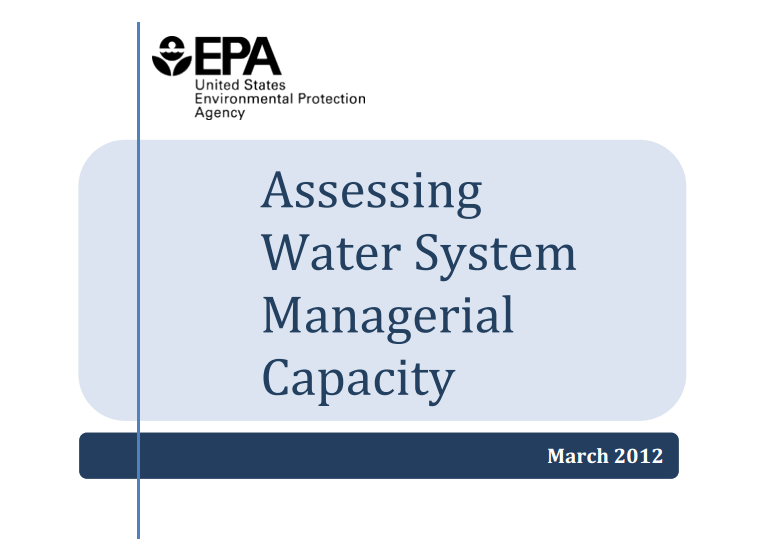Caroline Simpson is a graduate student with the UNC School of Information and Library Science and works as a Research Assistant with the Environmental Finance Center.
Utility managers may find new perspectives on water system managerial capacity in an unfamiliar place. Last March, the U.S. Environmental Protection Agency, along with a national Managerial Capacity Workgroup, which included the EFC’s Shadi Eskaf, published the Assessing Water System Managerial Capacity Guidebook (pdf). Aimed at aiding the state primary agencies’ Capacity Development Programs in crafting approaches and choosing indicators to monitor and measure water systems’ managerial capacity, this guide offers many concepts and ideas from a broader state-level outlook that utility managers may find insightful and relatable. “Managerial capacity” is defined in the document as the water system’s institutional and administrative capabilities that enable a water system to conduct its affairs in a manner enabling the system to achieve and maintain compliance with the Safe Drinking Water Act (SDWA) requirements.
The document describes the approaches a state can take to measure water systems’ managerial capacity through the use of quantitative and qualitative indicators. Examples of typical indicators include well-defined employee responsibilities, established emergency policies, compliance with regulations, opportunities for staff trainings, governing body transparency and accountability, and many more. Viewing managerial capacity indicators as pieces of a puzzle that are dependent upon one another rather than isolated actions is an underlying theme of the guidebook. Before delving into managerial capacity as a stand-alone factor, the guidebook offers approaches to assessing technical, managerial, and financial (TMF) capacity holistically, since many of the proposed indicators can be used to assess more than just managerial capacity.
States typically form unique plans to assess managerial capacity of water systems that fit their unique situations. The guidebook does not prescribe one approach or one way of assessing managerial capacity, but rather presents several options that states can consider and build their managerial capacity assessments from. The bulk of the guidebook walks states through common considerations and important questions to ask about how to measure or assess capacity. It specifically investigates 12 themes, from Transparency and Accountability to Compliance. Each theme offers possible associated indicators, example questions for use in a questionnaire or in-person interviews, and potential follow-up actions. The most helpful aspect of these focused sections is that each indicator is accompanied by examples of that indicator in a strong, moderate or weak phase. Utility managers can use these profiles of common managerial capacity themes to think about their own indicators, examine their own strengths and weaknesses, bring clarity to some of the more ambiguous indicators, or change their view of what a successful indicator of managerial capacity (some may call it “leadership”) really looks like.
The EPA guidebook to the states primacy agencies is similar to a work produced specifically for utilities: the Water Effective Utility Management (EUM) model. From the EUM model, a “Primer for Water and Wastewater Utilities” was produced that includes ten attributes of effectively managed water sector utilities, with their own examples of measureable indicators of a well-managed water system. The EUM model is more directed towards water utility managers themselves, whereas the EPA guidebook is written for states to assess overall managerial capacity of all water systems in one state. The EPA guidebook for states is a good supplement to the EUM primer because their recommendations overlap and yet they maintain their own nuances to approach because of their audience. For example the EPA guidebook discusses “Customer Education/Support” in terms of the customer’s right to know about new regulations, current issues, and the use of Consumer Confidence Reports (CCR) and the Public Notification (PN) rule. On the other hand, the EUM primer discusses “Customer Satisfaction” and focuses on offering customers affordable, timely, and reliable services. Here, two perspectives on communicating with customers are valuable because they both say a lot about successful managerial capacity and illustrate two avenues of customer relations.
At the EFC, we are interested to know and assist utilities as well as states assess the financial and managerial capacity of water systems. We have learned that there is no commonly-accepted standard way of assessing these capacities across different states, although there appears to be great desire to find quantifiable, measurable indicators that can help utilities track where they are at and monitor their progress over time.





Leave a Reply